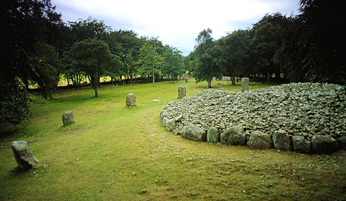A diagram which demonstrates why the moon goes through phases.
Click on image for full size
Phases of the Moon
The diagram shows the Moon in different positions along its orbit
around the Earth. The Sun is far away and acts like a light bulb in
this picture. Half of the Moon is always reflecting light from the Sun
(let's call it the light side), and half of the Moon is always in
shadow (the dark side). But that's not all that is happening. Only
half of the Moon is facing the Earth so that we can see it (let's call
it the near side). The other half is facing away from the Earth (the
far side). The phases occur because the near side isn't always the
side reflecting light from the Sun.
When the Moon is between the Earth and the Sun (labelled 1), the side
of the Moon facing the Earth is the dark side. The Moon cannot be
seen. We call this the New Moon because it begins a new cycle of
phases. When the Earth is between the Sun and the Moon (5), the side
facing the Earth is the light side. We call this Full Moon, even
though we can only see half the Moon at one time.
Halfway in between these times (3 & 7), only half of the near side of
the moon is reflecting sunlight. So we can only see one-quarter of
the Moon. We call these phases First and Third Quarters.
All the phases of the Moon have special names
which indicate how much of the illuminated Moon can be seen from
Earth, and whether this part is going to grow or shrink.
You might also be interested in:

What phase was the Moon in on December, 22 1962? How long does it take the Moon to travel from one phase to the next? Suppose that the Moon spun twice on its axis during each orbit around the Earth. How
...more
People have been living in North America for a long, long time. The first people to live there were the Native Americans. They didn't have clocks or calendars so they watched tides, the Sun, the Moon,
...more
Do you know anybody who has a nickname? Did you know that the Full Moon has a bunch of nicknames? Native Americans who lived in the North and East parts of North America had many nicknames for the Full
...more
The Leonid meteor shower is one of several major meteor showers that occur on roughly the same date each year. The Leonids typically "peak" (are at their greatest level of activity) in mid to late November.
...more
Man has always observed the sky. By watching the Sun and Moon, early man could tell what season was coming next. They had to know this to be able to farm and hunt. Archeoastronomy started in the 1960's
...more
The stones of Carnac, France, are very famous because there are a lot of them and because they are so old! The oldest stones found in Carnac are from about 4,500 B.C. That's older than the stones at Stonehenge!
...more
You may have heard of the lake called Loch Ness, where people think they've seen the Loch Ness monster. Near Loch Ness there are three giant stone tombs you may not have heard of...they are called the
...more















